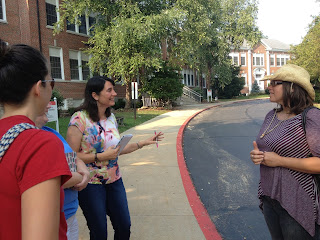While I was away on retreat, another school gardenin' mom was busy helping to organize parent efforts to help with the Tillman's cafeteria composting kick-off for the year. I had a great time when I came back, diving into trashcans and showing kids how to sort their compost/recycling/landfill items after lunch. It's a dirty job, but not many things are more fun! Matter of fact, I'm leaving in a few minutes to go experience this with the kindergartners today:)
This week was full of exciting developments both at Tillman and Nipher. This same parent who was organizing composting also entered Tillman and Nipher into a sustainability in education contest sponsored by the St. Louis chapter of the U.S. Green Building Council (USGBC). Both schools were accepted, and matched with a USGBC member who's a professional somehow related to green building and sustainability. At Tillman, we were matched with Nancy Nafe, a LEED certified landscape architect. At Nipher, it's Michelle Rook, a local architect in town who is going to help us start an after-school composting club that will begin composting in the Nipher cafeteria. Finally, there was also a Tillman sustainability committee visioning session. This group of parents, teachers, and administrators got together to dream big about a vision of sustainability for our school.
I can really start to envision how big changes are going to become a reality here in the Kirkwood Schools. When people aren't afraid to dream big, and are also willing to invest their time, energy, and talents, anything is possible! Below is the email I just sent out to all the people involved in the sustainability group at Tillman, detailing our longterm dreams and short-term goals. It will be a great document to come back to in a few years to see how far we've come!
October 25, 2013
Hi everyone!
I hope this email finds you all well. It has been an exciting week for sustainability at Tillman. Below is an update that encapsulates results from Tuesday afternoon's committee visioning session and a meeting between myself, Jaime Kelley (another parent volunteer heading this up), and Nancy Nafe (a landscape architect serving as Tillman's sustainability mentor for the next 6 months for a contest called Green Schools Quest). The email is the nutshell version, if you want more details, I've included links of meeting notes. As always, please pass this along to interested folks and call me with any questions!
Finally, if you would like to take a leadership role in any of the areas listed below, just contact me. This group is chock-full of passionate people with amazing resources, and we want you to plug in where it suits you best! Some of you have indicated that you want to be "doers", not planners, so for you this is just to keep you up-to-date and in-the-know:)
Lesli @ 314-368-0500
Visioning meeting agenda https://docs.google.com/document/d/1O58tjs_bAu6zfLcp772yR3OJgKv_R9z9HNuTXBDWn60/edit?usp=sharing
What is sustainability? It’s the ability to meet the needs of the current generation without compromising the needs of future generations. The Iroquois idea of considering impacts of actions to the 7th generation is a great example of this mindset.
Discussion questions
1. In terms of sustainability, where do you want to see Tillman in 10 years?
2.
How do we integrate the idea of sustainability with the service
learning and character education already happening at Tillman?
3. How to balance student leadership and adult direction as we move toward our goals?
4. How can we support teachers, whose plates are so full already?
Wrap-up Each participant spoke about the sustainability goal that resonated the most with them
This
list in bold is what came out as highest priority for question 1
(long-term dreams, not the how-tos) to those in attendance. Until we
revise our vision, these are where we will invest most of our energy. It's neat to me that nothing on this list diverges from conversations I've had with folks connected to this committee over the past several months. Even though several of you couldn't make it to the meeting, I think it's likely you'll approve of the current emphasis!
- Getting fresh, local, organic food into cafeteria, whether it be through farmer partnerships, helping change food service procurement practices, or growing food at Tillman
- Assessing school environment and practices for health impact on students (food, air and water quality, opportunity for outdoor time and physical activity--think energy audit, wellness audit, etc.)
- Involvement in food equity (in and beyond Kirkwood, high desire to partner with a community in need)
- Integrating sustainability into curriculum and culture of school
Meeting with landscape architect
https://docs.google.com/document/d/1JAxQ3B4ryTnwEkNg7qmrRkQnUptwNHGmdGTmqM44T9E/edit
- Green Schools Quest is a contest sponsored by the St. Louis Chapter of the US Green Building Council. This program assigns mentors from the professional community to help schools develop and implement a sustainability-related project over the course of about 6 months. In March, we will be required to submit a presentation about our project. If we win, we get cool stuff and some moulah. I think we will win.
- Our mentor: Nancy Nafe, landscape architect, LEED certified, she recently designed Maplewood-Richmond Heights' new kitchen garden at their high school.
- Our goals for the Quest (some are new, some our committee decided on awhile ago--but this plan includes specific folks to head up different things, and that's in the works!)
- The plan between now and March:
- Increase amount of food we are growing
- Raising awareness about sustainability, "marketing" to students, families, and teachers
- Prairie installation
- Sensory Garden installed near playground
- Visioning sessions with students and adults that will culminate in a long-range landscape design







